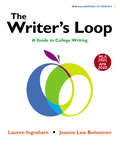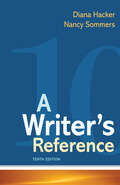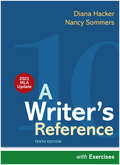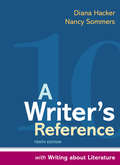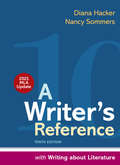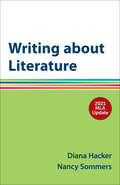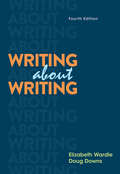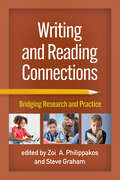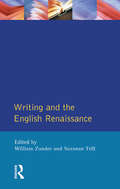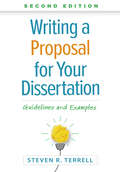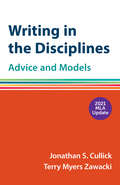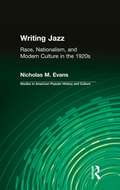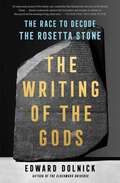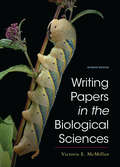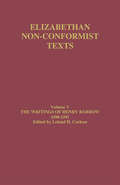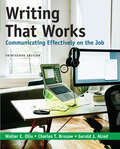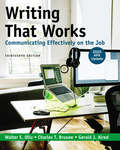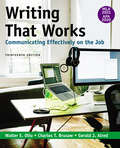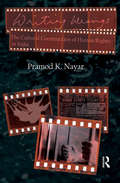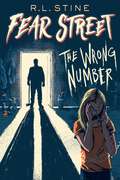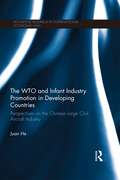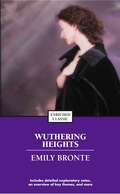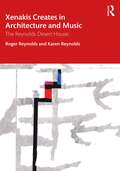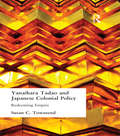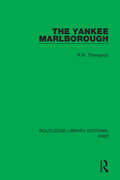Special Collections
Benetech’s Global Certified Accessible Titles
Description: Benetech’s GCA program is the first independent third-party EPUB certification to verify ebook accessibility. By creating content that is born accessible, publishers can meet the needs of all readers. Learn more: https://bornaccessible.benetech.org/
- Table View
- List View
The Writer's Loop with 2020 APA and 2021 MLA Updates
by Lauren Ingraham and Jeanne BohannonThis ebook has been updated to provide you with the latest guidance on documenting sources in MLA style and follows the guidelines set forth in the MLA Handbook, 9th edition (April 2021).The Writer’s Loop, presents a refreshing, practical approach to writing, based on the habits of strong writers, who pause often, reflect, and loop backwards and forwards as they revise on their way to a final draft. With integrated videos, relatable examples, clear explanations, and a consistent, scaffolded learning framework, each brief chapter engages writers through reflection and practices that support the most common types of academic writing, including essays, arguments, and research projectsAchieve with Ingraham and Bohannon, The Writer’s Loop combines instruction with integrated videos, powerful writing tools, and customizable multi-draft writing assignments.
A Writer's Reference
by Diana Hacker and Nancy SommersEngage more. Achieve more.A Writer’s Reference helps you engage in and meet the challenges of your writing course. Clear How-to boxes help you complete common writing assignments like argument and analysis. Guidance about paraphrasing and fact-checking sources help you become a more responsible writer and reader. And Notes-to-self help you reflect on your progress and plan your revision. If your instructor has assigned Achieve, you have new ways to engage with course material and with your instructor and peers. Revision planning tools and individualized study plans help you become a better writer, and a built-in e-book puts your problem and your solution side by side.
A Writer’s Reference with Exercises
by Diana Hacker and Nancy SommersA Writer’s Reference has offered clear and quick answers to tough questions for millions of college writers. With a groundbreaking tabbed, lay-flat format and a first-of-its-kind directness, it helped a generation of students engage in their own writing and meet the challenges of the composition course. As we celebrate the 10th edition, we invite you to see our latest innovation--our latest answer to the question we have been asking for 35 years: How can we help? We help with superior content developed by experienced authors and shaped by faculty and student advisers. And we help with Achieve, a first-of-its-kind suite of digital tools paired with content you trust.
A Writer’s Reference with Writing about Literature
by Diana Hacker and Nancy SommersWriting about Literature is a practical guide to interpreting works of literature and to planning, composing, and documenting papers about literature. Students will find help with forming and supporting an interpretation, avoiding plot summary, integrating quotations from a literary work, observing the conventions of literature papers, and using secondary sources. Writing about Literature also includes two sample student essays — one that uses only a primary source and one that uses primary and secondary sources.
A Writer's Reference with Writing about Literature, with 2021 MLA Update
by Diana Hacker and Nancy SommersThis ebook has been updated to provide you with the latest guidance on documenting sources in MLA style and follows the guidelines set forth in the MLA Handbook, 9th edition (April 2021).Writer's Reference with Writing about Literature, is a practical guide to interpreting works of literature and to planning, composing, and documenting papers about literature. Students will find help with forming and supporting an interpretation, avoiding plot summary, integrating quotations from a literary work, observing the conventions of literature papers, and using secondary sources. Writer's Reference with Writing about Literature also includes two sample student essays — one that uses only a primary source and one that uses primary and secondary sources.
Writing about Literature with 2021 MLA Update
by Diana Hacker and Nancy SommersThis ebook has been updated to provide you with the latest guidance on documenting sources in MLA style and follows the guidelines set forth in the MLA Handbook, 9th edition (April 2021).Writing about Literature is a practical guide to interpreting works of literature and to planning, composing, and documenting papers about literature. Students will find help with forming and supporting an interpretation, avoiding plot summary, integrating quotations from a literary work, observing the conventions of literature papers, and using secondary sources. Writing about Literature also includes two sample student essays — one that uses only a primary source and one that uses primary and secondary sources.
Writing about Writing
by Elizabeth Wardle and Doug DownsSince its initial publication, Writing about Writing has empowered tens of thousands of students to investigate assumptions about writing and to explore how writing works. It does so by making writing itself the subject of inquiry. Unique to Wardle and Downs’ approach, the text presents “threshold concepts” about writing―central ideas that writers need to understand in order to progress. As they come to a deeper understanding of these threshold concepts, students are able to transfer their understanding to any writing situation they encounter. This new edition has been refined and improved based on input from instructors using the text. Now with more explicit instruction to support academic writers, a new Part One explains the value of investigating writing, introduces threshold concepts and the notion of transfer, details the elements of genre and rhetorical reading, and offers a guide for conducting writing studies research at a level appropriate for undergraduates. The readings chapters have been updated and streamlined, and as in past editions they are supported with introductions, scaffolded questions, and activities. An extensive Instructor’s Manual by teacher-trainer Matt Bryan provides support for teaching with a writing-about-writing approach.
Writing and Reading Connections
by Steve Graham and Zoi A. PhilippakosWriting skills are essential for success in the 21st-century school and workplace, but most classrooms devote far more time to reading instruction, with writing often addressed in isolation or excluded. In this insightful professional development resource and text, leading researchers discuss why and how to integrate writing and reading instruction in grades K–12 and beyond. Contributors explore how to harness writing–reading connections to support learning in such areas as phonics and spelling, vocabulary, understanding genre and text structure, and self-regulated strategy development, as well as across content areas and disciplines. Special considerations in teaching emergent bilingual students and struggling literacy learners are described. User-friendly features include guiding questions, classroom examples, and action questions that help teachers translate the research and concepts into practice.
Writing and the English Renaissance
by William Zunder and Suzanne TrillWriting and the English Renaissance is a collection of essays exploring the full creative richness of Renaissance culture during the sixteenth and seventeenth centuries. As well as considering major literary figures such as Spenser, Marlowe, Donne and Milton, lesser known - especially women - writers are also examined. Radical writing and popular culture are considered as well. The scope of the study not only extends the parameters for debate in Renaissance studies, but also adopts a radical interdisciplinary approach, bridging the gap between literary, historical, cultural and women's studies, leading to a much fuller picture of life in the sixteenth and seventeenth centuries.The authors discussed are placed in their full historical and literary context, with an extensive selection of original documentation included in the text - for example, from The Book of Common Prayer or the Homilies to contextualize the writing under discussion. This distinctive approach, combined with a detailed chronology of the period and bibliography, embracing both canonical and non-canonical writers, makes this volume a unique reference resource and course reader for Renaissance studies.
Writing a Proposal for Your Dissertation
by Steven R. TerrellThe encouraging book that has guided thousands of students step by step through crafting a strong dissertation proposal is now in a thoroughly revised second edition. It includes new guidance for developing methodology-specific problem statements, an expanded discussion of the literature review, coverage of the four-chapter dissertation model, and more. Terrell demonstrates how to write each chapter of the proposal, including the problem statement, purpose statement, and research questions and hypotheses; literature review; and detailed plans for data collection and analysis. "Let's Start Writing" exercises serve as building blocks for drafting a complete proposal. Other user-friendly features include case-study examples from diverse disciplines, &“Do You Understand?&” checklists, and end-of-chapter practice tests with answers. Appendices present an exemplary proposal written three ways to demonstrate quantitative, qualitative, and mixed methods approaches, and discuss how to structure a four-chapter dissertation. New to This Edition *Introduction offering a concise overview of the entire proposal-writing process and the doctoral experience. *Additional help with tailoring problem and purpose statements for quantitative, qualitative, and mixed-methods studies. *Expanded discussion of the review of literature, including a criterion for judging the quality of primary versus secondary sources. *Many new examples from different disciplines, such as studies of depression treatments, approaches to reducing offender recidivism, health effects of irradiated crops, strength training in college football, and remote teaching and learning during COVID-19. *Focus on the five-chapter model is broadened to include specific guidance for four-chapter dissertations. *Broader, more detailed reference list and glossary.
Writing in the Disciplines with 2021 MLA Update
by Diana Hacker and Nancy Sommers and Jonathan S. Cullick and Terry Myers ZawackiThis ebook has been updated to provide you with the latest guidance on documenting sources in MLA style and follows the guidelines set forth in the MLA Handbook, 9th edition (April 2021).With practical advice and plenty of student models, Writing in the Disciplines provides a jump start for writing college papers in nine disciplines — biology, business, criminal justice/criminology, education, engineering, history, music, nursing, and psychology. Each discipline section features information on audience expectations in that area of study, the types of questions asked, the types of documents produced, the kinds of evidence used, appropriate language conventions, and appropriate citation styles. Each section features a model student paper (two in business) written in response to a typical assignment in the discipline. Advice for writing in business, criminal justice, education, nursing, and psychology includes updated APA guidelines (2020).
Writing Jazz
by Nicholas M. EvansFirst published in 2001. Routledge is an imprint of Taylor & Francis, an informa company.
The Writing of the Gods
by Edward DolnickThe fast-paced and &“engrossing account&” (The New York Times Book Review) of &“one of the greatest breakthroughs in archaeological history&” (The Christian Science Monitor): two rival geniuses in a race to decode the writing on one of the world&’s most famous documents—the Rosetta Stone.The Rosetta Stone is one of the most famous objects in the world, attracting millions of visitors to the British museum every year, and yet most people don&’t really know what it is. Discovered in a pile of rubble in 1799, this slab of stone proved to be the key to unlocking a lost language that baffled scholars for centuries. Carved in ancient Egypt, the Rosetta Stone carried the same message in different languages—in Greek using Greek letters, and in Egyptian using picture-writing called hieroglyphs. Until its discovery, no one in the world knew how to read the hieroglyphs that covered every temple and text and statue in Egypt. Dominating the world for thirty centuries, ancient Egypt was the mightiest empire the world had ever known, yet everything about it—the pyramids, mummies, the Sphinx—was shrouded in mystery. Whoever was able to decipher the Rosetta Stone would solve that mystery and fling open a door that had been locked for two thousand years. Two brilliant rivals set out to win that prize. One was English, the other French, at a time when England and France were enemies and the world&’s two great superpowers. Written &“like a thriller&” (Star Tribune, Minneapolis), The Writing of the Gods chronicles this high-stakes intellectual race in which the winner would win glory for both himself and his nation. A riveting portrait of empires both ancient and modern, this is an unparalleled look at the culture and history of ancient Egypt, &“and also a lesson…in what the human mind does when faced with a puzzle&” (The New Yorker).
Writing Papers in the Biological Sciences
by Victoria E. McMillanWritten by a professional biologist and experienced writing teacher, this comprehensive guide for students provides detailed instruction on researching, drafting, revising, and documenting lab reports, research papers, reviews, poster presentations, and other commonly assigned projects in biology courses. The seventh edition features updated coverage of research methods and new student examples from a wider variety of sub-disciplines in biology that support students at all levels of biology.
The Writings of Henry Barrow, 1590-91
by Leland H. CarlsonThis volume contains the great Separatist's solus writings from 1590-1591. It includes texts taken from manuscript sources, and rare tracts that have been reprinted here for the first time.
Writing That Works
by Gerald Alred and Charles Brusaw and Walter OliuMore than ever, Writing That Works is the right choice for the most up-to-date coverage of business writing. Real-world model documents are grounded in their rhetorical contexts to guide students in navigating the increasingly complex world of business writing. Now in full-color, the thirteenth edition continues to reflect the central role of technology in the office and the classroom, showcasing the most current types of business documents online and in print, providing succinct guidelines on selecting the appropriate medium for your document, communication, or presentation, and featuring new advice on creating a personal brand as part of a successful job search. Also available as an e-book and in loose-leaf, Writing that Works offers robust but accessible coverage at an affordable price.
Writing That Works
by Gerald Alred and Charles Brusaw and Walter OliuWith 2020 APA Update. More than ever, Writing That Works is the right choice for the most up-to-date coverage of business writing. Real-world model documents are grounded in their rhetorical contexts to guide students in navigating the increasingly complex world of business writing. Now in full-color, the thirteenth edition continues to reflect the central role of technology in the office and the classroom, showcasing the most current types of business documents online and in print, providing succinct guidelines on selecting the appropriate medium for your document, communication, or presentation, and featuring new advice on creating a personal brand as part of a successful job search. Also available as an e-book and in loose-leaf, Writing that Works offers robust but accessible coverage at an affordable price.
Writing That Works: Communicating Effectively on the Job with 2020 APA and 2021 MLA Updates
by Gerald J. Alred and Charles T. Brusaw and Walter E. OliuThis ebook has been updated to provide you with the latest guidance on documenting sources in MLA style and follows the guidelines set forth in the MLA Handbook, 9th edition (April 2021).More than ever, Writing That Works is the right choice for the most up-to-date coverage of business writing. Real-world model documents are grounded in their rhetorical contexts to guide students in navigating the increasingly complex world of business writing. Now in full-color, the thirteenth edition continues to reflect the central role of technology in the office and the classroom, showcasing the most current types of business documents online and in print, providing succinct guidelines on selecting the appropriate medium for your document, communication, or presentation, and featuring new advice on creating a personal brand as part of a successful job search. Also available as an e-book and in loose-leaf, Writing that Works offers robust but accessible coverage at an affordable price.
Writing Wrongs
by Pramod K. NayarThis book examines the ‘cultural apparatus’ of Human Rights in India today. It unravels discourses of victimhood, oppression, suffering and witnessing through a study of autobiographies, memoirs, reportage and media coverage, and documentaries. Moving across multiple media and genres for their representations of Dalits, riot victims, prisoners, abused and abandoned women and children, examining the formal properties of victim texts for their documentation of trauma, and analyzing the role of the sympathetic imagination, Writing Wrongs inaugurates a whole new field in literary–cultural studies by focusing on the narratives that build the culture of Human Rights. It argues for taking this cultural apparatus as essential to the political and legal dimensions of Human Rights. The book emphasizes the need for an ethical turn to literary–cultural studies and a cultural turn to Human Rights studies, arguing that a public culture of Human Rights has a key role to play in revitalizing civil society and its institutions. It will be of interest to Human Rights scholars and activists, and those in political science, sociology, literary and cultural studies, narrative theory and psychology.
The Wrong Number
by R.L. StineIt begins as an innocent prank: Deena Martinson and her best friend, Jade Smith, make sexy phone calls to the boys from school. But Deena’s half-brother, Chuck, catches them in the act and threatens to tell their parents—unless the girls let him in on the fun. Chuck begins making random calls, threatening anyone who answers. It’s dangerous and exciting. The teens are even enjoying the publicity and the uproar they’ve caused. Until Chuck calls a number on Fear Street.
The WTO and Infant Industry Promotion in Developing Countries
by Juan HeThe charter of the World Trade Organization (WTO) sets the tone that sustainable trade and economic development dominates multilateral trade negotiation and specific working agreements. This book examines the novel challenge for developing countries to upgrade and optimize their industrial structure and trade composition by stimulating genuinely innovative and competitive industrial strength. The book specifically explores the issue of infant industry promotion under the legal framework of the WTO treaties and case law. Taking the regulatory measures and incentives China has used to build up a large civil aircraft supplier, the book evaluates the key trade agreements relevant to infant industry promotional policies and practices, such as product regulations and standards under the 'Agreement on Technical Barriers to Trade', and export promotion policies under the 'Agreement on Subsidies and Countervailing Measures'. Juan He argues that the regulatory room prescribed by the multilateral trade rules of the WTO does not allow adequate space for developing countries to encourage new and technologically advanced areas of production and trade. The author concludes by suggesting ways in which WTO rules could be modified to help enable developing countries’ industrialization. In doing so, the book highlights a need to investigate how localized and international policy trends can be reconciled and enhanced towards the common goal of development. The book will be of great interest to scholars and students of international trade law, Chinese studies, international political economy, and of great use to government agencies responsible for internal trade and industrial policy decisions.
Wuthering Heights
by Emily BrontëENDURING LITERATURE ILLUMINATEDBY PRACTICAL SCHOLARSHIPThe unforgettable story of Heathcliff and Catherine, whose doomed love torments them in a tempest of madness, vengeance, and redemption. EACH ENRICHED CLASSIC EDITION INCLUDES: A concise introduction that gives readers important background information A chronology of the author's life and work A timeline of significant events that provides the book's historical context An outline of key themes and plot points to help readers form their own interpretations Detailed explanatory notes Critical analysis, including contemporary and modern perspectives on the work Discussion questions to promote lively classroom and book group interaction A list of recommended related books and films to broaden the reader's experienceEnriched Classics offer readers affordable editions of great works of literature enhanced by helpful notes and insightful commentary. The scholarship provided in Enriched Classics enables readers to appreciate, understand, and enjoy the world's finest books to their full potential. SERIES EDITED BY CYNTHIA BRANTLEY JOHNSON
Xenakis Creates in Architecture and Music
by Roger Reynolds and Karen ReynoldsXenakis Creates in Architecture and Music describes the collaborative interaction of internationally acclaimed composer Roger Reynolds, musician Karen Reynolds, and musically inspired composer, engineer, and architect Iannis Xenakis (1922-2001) to create a house design, The Reynolds Desert House. The process combined aesthetics and intuition with mathematical systems, showcasing how art and science are balanced—by way of music and architecture—to address the essential technical aspects of music along with the role of emotion and energy. The book analyzes three representative chamber works and presents a trove of primary sources: letters, diaries, notes, photographs, sketches, and person-to-person conversations. What emerges are patterns of direct parallels between how Xenakis characterized the process of musical creation and his design of The Reynolds Desert House. Xenakis Creates in Architecture and Music is a testament to the singularly innovative and creative mind of Iannis Xenakis. Supplementary materials—including color reproductions of black and white images in the book—can be found at: www.rogerreynolds.com/xenakisreynoldsroutledge.html
Yanihara Tadao and Japanese Colonial Policy
by Susan C TownsendThe first comprehensive analysis of the colonial writings of Yanaihara Tadao whose extensive commentary on Japanese and European colonial policy is remarkable not only for its scholarly integrity but also for its sheer breadth.
The Yankee Marlborough
by R.W. ThompsonThis book, first published in 1963, is an early biography of Winston Churchill, examining his personality and character that was woven so closely through the texture of Britain’s story in the first half of the twentieth century. In attempting to discover a complete and complex Churchill, in his character, ambitions and personal experiences, the book seeks to present a clearer insight into the events of Churchill’s life.
